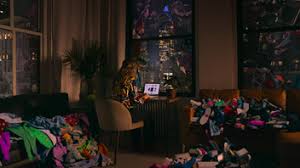Buy Now! The Shopping Conspiracy 2024 Movie Review
If you’re a Good Person (TM), you’ve probably taken your broken or unwanted electronics to an e-waste disposal site. Maybe a friendly Staples employee has promised to recycle your laptop or phone safely, so that toxic materials don’t end up in your city dump. But the new Netflix documentary, Buy Now: The Shopping Conspiracy,—which began streaming today—exposes what actually happens to many of those so-called recycled electronics: They are shipped overseas for poorer countries to deal with.
Written and directed by Nic Stacey, Buy Now is a searing indictment on modern consumerism and waste. Not only is human garbage production at an all-time high, the garbage we’re producing is increasingly toxic waste. That’s thanks to the rise of personal electronics, which are made from hazardous materials including mercury, lead, arsenic, cadmium and other toxins, all of which can cause severe health problems, if exposed. Yet every day people in developing countries are receiving so-called recycled electronics from the West, and they salvaging them for parts while wearing little-to-no protective gear.
For this section of the film, Stacey features Jim Puckett, the founder of a non-profit organization fighting to reduce toxic waste, called Basel Action Network. But in Buy Now, Puckett is identified as a “waste investigator.” It soon becomes clear why: He and his team install trackers in old electronics, take those electronics to waste disposal facilities, and track where the e-waste ends up.
“Right now, today, we’re tracking about 400 devices,” Puckett explains in his talking head interview. “We like to use LCD flat-screen monitors. We’ll put the track in a place like right here, put it all back together, and we deliver it to a so-called recycler. And then we see what really happens to it.”
Puckett demonstrates a tracker he followed from a recycling center in Dresden, Germany, where it was sent to Antwerp, Belgium, and then, eventually, to Thailand. Though it’s supposed to be illegal to ship this type of electronic waste overseas, Puckett says exporters can easily bypass customs by pinning a crisp hundred-dollar bill inside the shipping containers. When several of their trackers ended up in Pattaya City, Thailand, Puckett paid that spot a visit.
“When I arrived, I found an appalling scene,” Puckett says in the film.” The workers were actually smashing this stuff apart by hand, releasing a lot of very toxic substances in the process.”
In other words, bringing your toxic e-waste to a recycling facility is, oftentimes, simply a roundabout way of dumping your hazardous trash in a developing country.
“The reason it moves across the planet is to take advantage, to exploit, a weaker economy to do something that would, properly, cost a lot of money to do,” Puckett explains. “They’re making someone else pay—but they’re paying not with money, they’re paying with their health. Ingredients in electronics includes heavy metals, cadmium, lead, mercury, brominated flame retardants—which can cause all kinds of problems with cancer and reproductive disorders. These things are not just litter. These things are hazardous waste.”
So what can you do instead? The obligatory call-to-action finale of the movie suggests holding on to your electronics for as long as possible, or regifting what you don’t want anymore. If possible, try to get your broken devices fixed, before opting to throw them away. (Or, if you’re like me, simply keep all your old laptops and phones in a box in your closet indefinitely.) Of course, Apple and other tech companies don’t make this easy—in fact, they encourage the opposite.
As Nirav Patel, current CEO of Framework and former software development engineer at Apple, says in the film, “In my own personal experience, if you’re a designer or engineer in one of these companies, waste never enters the conversation. There is no meeting within a company building a laptop or phone or other device that’s, ‘Let’s talk about what happens as the end of life.’”
Real change would come from these companies changing the design approach to consider the end-of-life of electronic products. For that to happen, government regulations would need to be created and enforced. In the meantime, you can do your part by simply buying less.




